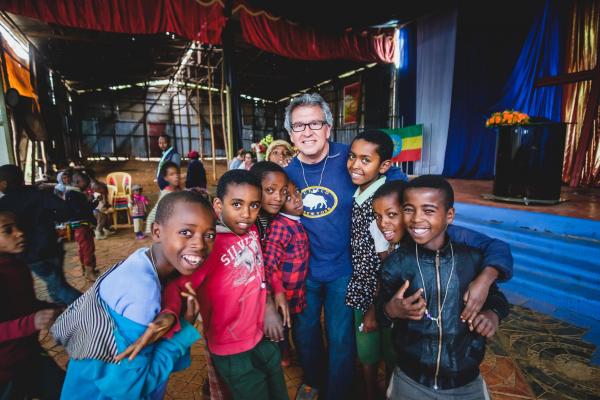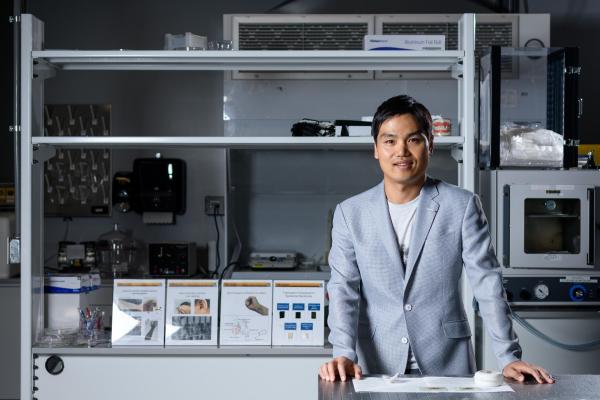Every semester a group of bioengineers at the Georgia Institute of Technology meets for lunch to play catch-up with each other, presenting their latest work, an informal show-and-tell. That’s how Rudy Gleason and W. Hong Yeo began a collaboration which has netted a $200,000 grant from the Bill & Melinda Gates Foundation.
At this particular gathering, Gleason gave a presentation of his work – a safe, low-cost, easy-to-use (and develop) 3D camera (utilizing an X-Box gaming system) to assess the risk of obstructed labor for patients in Ethiopia. But after hearing Yeo’s presentation about wearable device technology, Gleason approached him and said, “’What if we use your technology to monitor the health of neonates in Africa?’ In a minute we came up with this idea.”
The idea is to use Yeo’s wireless, wearable device for continuous health monitoring of neonates (infants under four weeks of age), who have the highest risk of mortality, particularly in the developing world. Yeo is developing the soft electronic sensor system for the project.
“Over the last 20 to 30 years, we’ve done a pretty good job at reducing childhood mortality rates, but actually if you look at the neonatal mortality rates, they’ve almost flatlined,” said Gleason, an associate professor in both the Wallace H. Coulter Department of Biomedical Engineering (BME) at Georgia Tech and Emory University and the George W. Woodruff School of Mechanical Engineering at Tech.
“This first month of life period is when about half of all child mortality happens and most of these neonatal deaths occur in the first week of life,” Gleason adds.
Yeo, assistant professor in the Woodruff School and the Coulter Department, has developed a small, wireless, wearable electronic device that would adhere on an infant’s chest like a Band-Aid and communicate to a tablet or smartphone to offer real-time, continuous monitoring of temperature, heart rate, respiratory rate, and blood oxygen concentration, with alarms for high risk conditions. It could provide timely indication to mothers and health care workers regarding hypothermia, apnea, asphyxia, respiratory distress, hypoxemia, oxygen oversaturation, neonatal infections, and sepsis.
“The hospitals we work with in Ethiopia really don’t monitor [the infants] very often – there are often too few probes, and healthcare workers must go to each neonate and take measurements of heart rate and blood/oxygen as they have time,” said Gleason. “So, I thought if we have a device like this that can continuously monitor four key parameters – heart rate, respiration rate, blood/oxygen level, and temperature – we could identify at-risk neonates while there is still time to intervene. This could reduce neonatal mortality in low-resource settings like Ethiopia.”
The funding will support a clinical pilot study among 50 neonates in the Neonatal Unit at Tikur Anbessa Specialized Hospital in Addis Ababa, Ethiopia, where Gleason and his research team will work with clinicians, engineers, and hospital staff to collect essential data, assess the efficacy, improve usability and participant acceptability, and assess the feasibility, market, and cost of local manufacturing of this all-in-one wearable device.
Leading the Ethiopian team are clinical researchers Asrat Demtse, who is a neonatologist, and Abebaw Fekadu, who heads up the Center for Innovative Drug Development and Therapeutic Trials for Africa (CDT-Africa, a sub-awardee on the Gates grant).
“We’re going to pilot this in hospitals, but I think the long-term version for this could be a first seven day-of-life baby monitor for at-risk newborns that a mother has connected to an app on her phone,” said Gleason. “That would be amazing. There’s a little bit of research between now and then to get that to work, but it can totally be an application. And even here in the U.S., we have sudden infant death syndrome, sleep apnea, etc. and this device could potentially catch all those things. I think this is an opportunity to save the lives of many babies.”
Media Contact
Keywords
Latest BME News
Jo honored for his impact on science and mentorship
The department rises to the top in biomedical engineering programs for undergraduate education.
Commercialization program in Coulter BME announces project teams who will receive support to get their research to market.
Courses in the Wallace H. Coulter Department of Biomedical Engineering are being reformatted to incorporate AI and machine learning so students are prepared for a data-driven biotech sector.
Influenced by her mother's journey in engineering, Sriya Surapaneni hopes to inspire other young women in the field.
Coulter BME Professor Earns Tenure, Eyes Future of Innovation in Health and Medicine
The grant will fund the development of cutting-edge technology that could detect colorectal cancer through a simple breath test
The surgical support device landed Coulter BME its 4th consecutive win for the College of Engineering competition.










